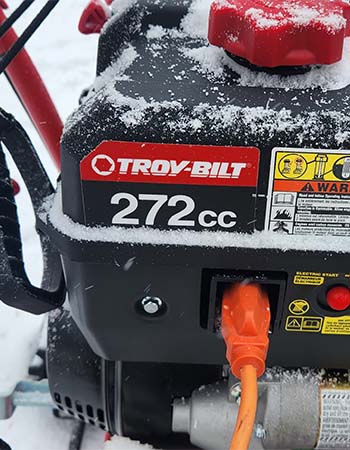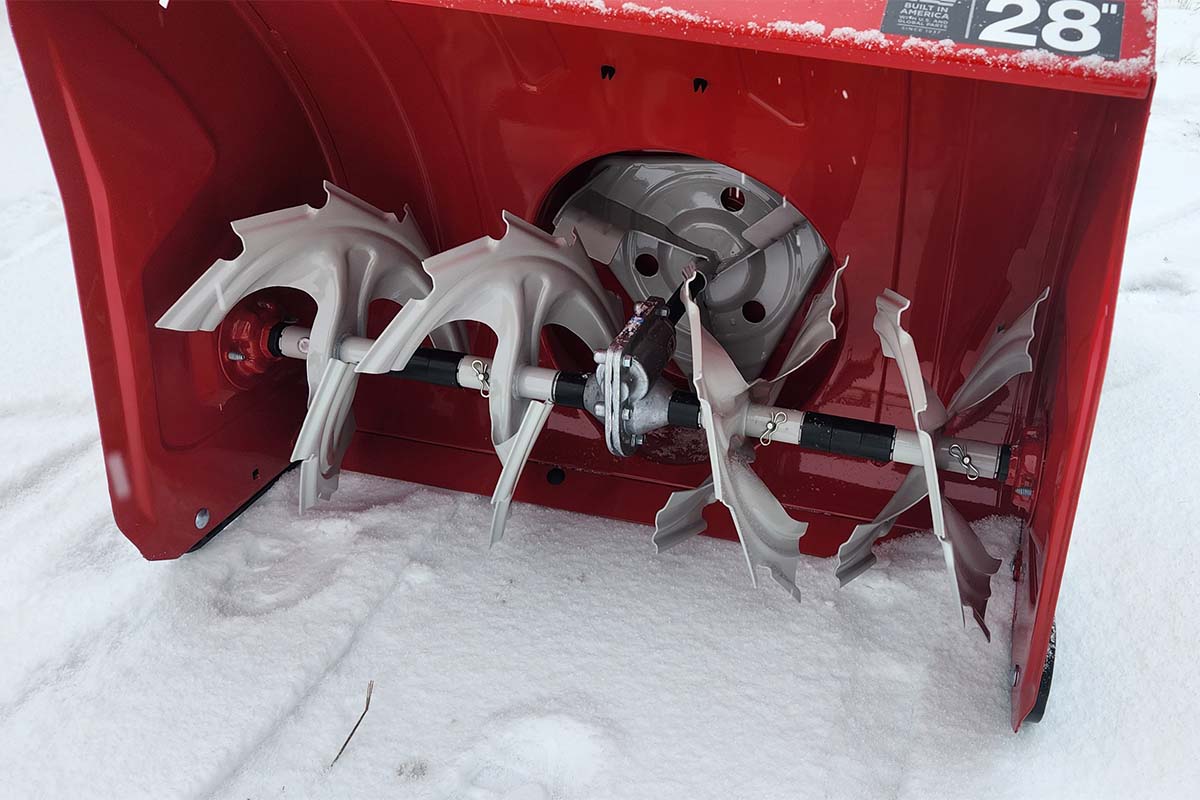We may earn revenue from the products available on this page and participate in affiliate programs. Learn More ›
Freezing temps and potentially icy surfaces can make snow-blowing a driveway a challenging task–even if the driveway is smooth concrete or asphalt. But not all driveways are made of concrete or asphalt. With gravel driveways, clearing snow can become even more difficult, thanks in part to the uneven surface. That’s why I tested a number of heavy-duty snow blowers on gravel surfaces at my home in rural Montana. The driveway is loose gravel and the road itself is compact gravel, both of which made for an ideal testing environment.
After testing 10 snow blowers, I found the Troy-Bilt Storm Tracker 2890 to be a standout for performance on gravel and difficult surfaces in general. The Storm Tracker 2890 is one product in a large lineup of outdoor power equipment made by Troy-Bilt, a manufacturer of lawn and garden products since 1937. The experience of this venerable company is evident in the build of the Storm Tracker 2890.
While there were plenty of other models that performed very well, the Troy-Bilt had a few unique features that set it apart. Read on to see why the Troy-Bilt Storm Tracker 2890 was our top pick among the best snow blowers for gravel driveways.
Troy-Bilt Storm Tracker 2890 Snow Blower: At a Glance

Rating: 9.6/10
SPECS
- Type: 2 stage
- Clearing width: 28 inches
- Intake height: 20 inches
PROS
- Tracks provide exceptional traction on ice and loose gravel surfaces
- Adjustable blade height offers plenty of clearance to avoid gravel contact
- Trigger-controlled touch and turn steering makes it easy to drive and maneuver
- Clears a wide path in just 1 pass
CONS
- More expensive than some similar 2-stage models on wheels
Get the Troy-Bilt snow blower for gravel driveways at:
What is the Troy-Bilt Storm Tracker 2890?
The Storm Tracker 2890 is built for durability and performance on difficult surfaces. Rather than traditional tires, it has tracks for more surface area contact and better traction. On loose gravel, the tracks make contact and move forward with minimal slipping. The same is true on icy surfaces. This sets it apart from the competition when working over gravel driveways.
Avoiding direct auger contact with gravel and gravel ingestion through the chute is also important. If rocks are flying and grinding through the auger and impeller, it will cause damage and eventual failure on any snow blower. That’s why skids are critical for setting the blade height above the ground surface. While this model has standard bolt-on skids, it also has a lever with three different height settings. Users can quickly make adjustments with this lever, ensuring the blade is always in the optimal position.
As a wide snow blower—28 inches—with a durable steel auger and high-speed impeller, this model will churn through wet snow, compact snow, and even icy snow conditions. It’s powerful and has two reverse settings and six forward-drive settings. A low setting can be used to work slowly through a mound of snow, while high gears can cover a large area in moderate snow. It throws snow over 40 feet and performs in the most difficult conditions.
Minor Assembly Required
Assembly is minimal and easy, but a few things need to be put together with the included hardware. The fold-down handle requires two bolt connections on each side to secure in place. The chute also requires some assembly; it simply drops in place and is secured by the connecting rods. The total assembly took less than 15 minutes and could likely be done much quicker.
Depending on where the snow blower was displayed or packaged, additional steps may be required. The throttle cable and chute-control cable may need to be connected. Although mine came with the cables connected, there are instructions for how to connect them in the directions. If cable connections are required, it’s easiest to make the connections before assembling the handle. It will leave enough slack to connect the throttle before bolting the upper handle to the lower frame.
Before engaging the engine, oil and gas must be added according to manufacturer directions. The gas cap also indicates the type of fuel that is acceptable.
Intuitive, User-Friendly Design
Operating the Storm Tracker 2890 is very simple, and the controls are easy to access. All that’s needed is a basic understanding of how small engines function—and to make sure the key is fully inserted. The snow blower won’t start without it fully inserted, which is an easy thing to forget.
To get it started, I just had to open the choke, press the primer five to seven times, and place the throttle on rabbit speed (as opposed to turtle). Then I had the option of using the pull start or the electric start button to fire the engine. I opted for the electric start, and it fired up immediately. After I let it run for a minute, I moved the choke to the closed position.
Outside of starting the engine, all of the controls are at the user’s fingertips. The chute-control and drive-speed handles are central on the main control panel. The auger and throttle controls are located on top of the handles, and the turn-control triggers are under the handles. Operating the snow blower will require a few minutes of practice for the user to get familiar with the controls. After playing with the trigger and speed settings, I found that operating this snow blower became second nature.

Easy Adjustments, Exceptional Traction
When it comes to clearing gravel, this snow blower really excels. The quick blade-height adjustments allowed me to raise the blades above the danger zone where loose gravel will contact the auger. I loved being able to raise the blade while working through big mounds of snow and deep sections. Most competing models only allow for skid-height adjustments, which aren’t always sufficient.
The tracks were a major differentiator, too, offering noticeably superior traction in side-by-side testing. The tracks didn’t spin, whereas other tires struggled. Many users place chains on tires in extreme conditions. With tracks, however, I found it’s not necessary. The tracks maintained traction, and having multiple speed settings helped me find the right pace to keep moving forward. I was able to crawl, hit a moderate speed, or move quickly. Backing out in reverse was also a cinch.
Is the Troy-Bilt Storm Tracker 2890 worth the money?
At close to $2,000, the Storm Tracker 2890 is a significant investment. There are less expensive options available and it’s worth shopping around a bit. For smaller gravel driveways, there are even two-stage electric snow blowers that perform really well. I think the price is reflective of the quality and capabilities, however. For big driveways and heavy storms, this was far and away the best gravel driveway model I tested.
As a gas engine–powered snow blower, it comes with maintenance costs, but that’s true of any gas model. In testing, this engine ran perfectly and started on the first pull. Regular maintenance (the occasional tune-up and oil change) should keep this powerful engine running smoothly for a long time.

Should you buy the Troy-Bilt snow blower?
If your gravel driveway is chewing up augers and impellers, it’s definitely time to consider something specifically designed for difficult surfaces. The cost of breaking shear pins and ruining augers will eventually exceed that of a new snow blower. For working on gravel, it’s well worth investing in something built to last and perform.
The amount of snow in your region will also impact snow blower choice. Gravel does absorb heat from the sun and it offers drainage for moisture. In areas with light snow events, there’s a good chance the snow will melt and drain away quickly. In these areas, there is little need for a snow blower. If the storms are more frequent but still moderate, a snow blower with good skids can handle most jobs.
For the northern residents who endure long winters and need to clear gravel driveways to access surface roads, a high-quality snow blower like this Troy-Bilt model is worth purchasing. Keep it maintained and it will deliver years of service. It can also run all day by simply topping off the gas tank when it gets low. This means you can handle a driveway, snow banks on roadways, and even help out the neighbors.
Where to Buy the Troy-Bilt 2890 Snow Blower
Get the Troy-Bilt snow blower for gravel driveways at:
Meet the Tester
Zach Lazzari is a freelance writer splitting time between the great outdoors, travel, and DIY projects ranging from camper builds to home renovations and maintenance. His home base in Montana is the perfect testing ground for winter products and snow equipment. With over a decade of professional writing experience, he also covers a variety of other projects and maintenance topics for BobVila.com.


